The University of Athens Observatory is offering its services in the field of asteroseismology, by observing several pulsating stars of RR Lyrae and δ Scuti type.
These observations were obtained in the frame of various international campaigns of observations for some interesting targets.
The international campaign on V1162 Ori was initiated in 1999 by Chris Sterken, and its goal was follow-up observations on this High-amplitude
δ Scuti Star (HADS), in order to recover its multiple periodicities. The target appeared to have many pulsation frequencies as expected.
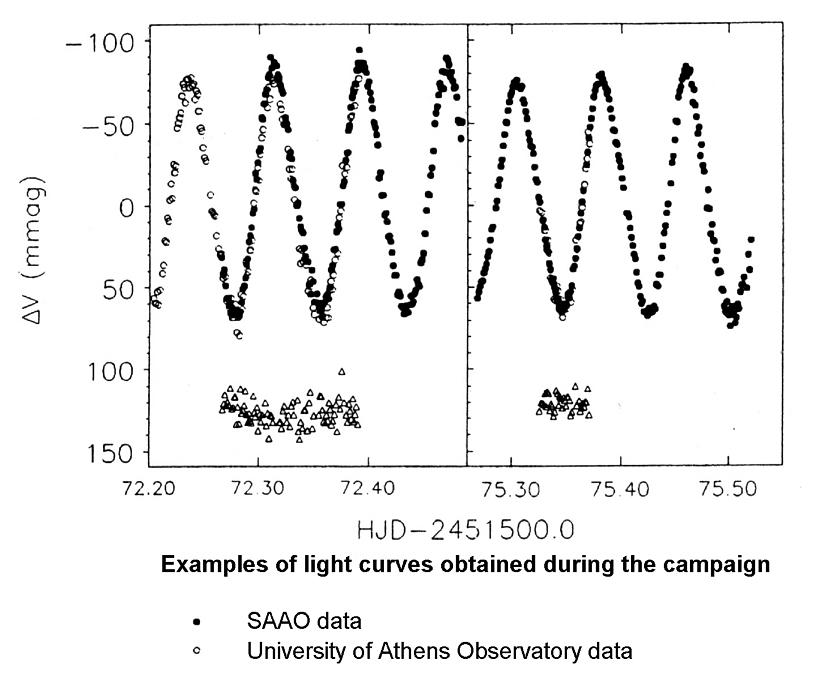 V1162 Ori is a High-amplitude δ Scuti Star (HADS), which was the first target ever observed from the University of Athens Observatory (images after Arentoft, T.; Sterken, C.; Handler, G.; Freyhammer, L. M.; Bruch, A.; Niarchos, P.; Gazeas, K.; Manimanis, V.; van Cauteren, P.; Poretti, E.; Dawson, D. W.; Liu, Z. L.; Zhou, A. Y.; Du, B. T.; Shobbrook, R. R.; Garrido, R.; Fried, R.; Akan, M. C.; Ibanoglu, C.; Evren, S.; Tas, G.; Johnson, D.; Blake, C.; Kurtz, D. W., "V 1162 Ori: A multiperiodic delta Scuti star with variable period and amplitude", 2001, A&A 374, 1056).
Comparison of simultaneous light curves from Athens (0.4-m telescope) and SAAO (1-m telescope) shows that high photometric accuracy can be obtained from a light polluted area.
V1162 Ori is a High-amplitude δ Scuti Star (HADS), which was the first target ever observed from the University of Athens Observatory (images after Arentoft, T.; Sterken, C.; Handler, G.; Freyhammer, L. M.; Bruch, A.; Niarchos, P.; Gazeas, K.; Manimanis, V.; van Cauteren, P.; Poretti, E.; Dawson, D. W.; Liu, Z. L.; Zhou, A. Y.; Du, B. T.; Shobbrook, R. R.; Garrido, R.; Fried, R.; Akan, M. C.; Ibanoglu, C.; Evren, S.; Tas, G.; Johnson, D.; Blake, C.; Kurtz, D. W., "V 1162 Ori: A multiperiodic delta Scuti star with variable period and amplitude", 2001, A&A 374, 1056).
Comparison of simultaneous light curves from Athens (0.4-m telescope) and SAAO (1-m telescope) shows that high photometric accuracy can be obtained from a light polluted area.
Pulsations of the peculiar subdwarf B star KPD 2109+4401 were investigated in Zhou, A.-Y.; Reed, M. D.; Harms, S.; Terndrup, D. M.; An, D.; Zola, S.; Gazeas, K. D.; Niarchos, P. G.; Ogloza, W.; Baran, A.; Wolf, G. W., "Resolving the pulsations of the subdwarf B star KPD 2109 + 4401", 2006, MNRAS, 367, 179 and in Reed, M. D.; Zhou, A.-Y.; Harms, S. L.; Wolf, G. W.; Terndrup, D. M.; An, D.; Kilkenny, D.; Chen, C.-W.; Chen, W.-P.; Lin, H.-C.; Zola, S.; Baran, A.; Ogloza, W.; Siwak, M.; Gazeas, K. D.; Niarchos, P. G.. "Follow-up observations of pulsating subdwarf B stars", 2006, MmSAI, 77, 476.
Continuous observations recovered the basic harmonics of this target.
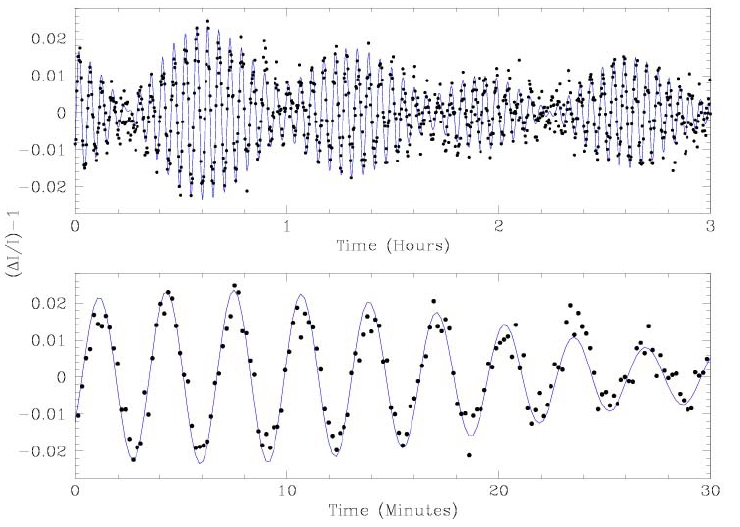
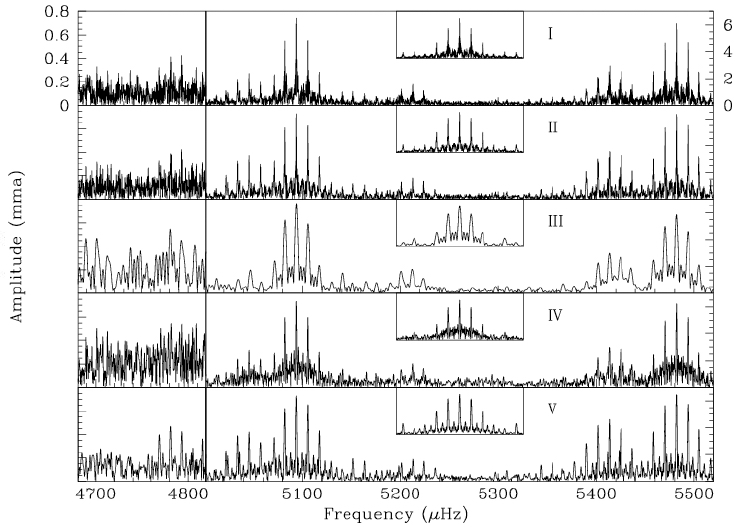
The unique photometric behavior of the peculiar subdwarf B star KPD 2109+4401.
A similar case was the investigation of the double-mode nature of the HADS star GSC 0144:3031 (Poretti, E.; Suarez, J. C.; Niarchos, P. G.; Gazeas, K. D.; Manimanis, V. N.; van Cauteren, P.; Lampens, P.; Wils, P.; Alonso, R.; Amado, P. J.; Belmonte, J. A.; Butterworth, N. D.; Martignoni, M.; Martin-Ruiz, S.; Moskalik, P.; Robertson, C. W., "The double-mode nature of the HADS star GSC 00144-03031 and the Petersen diagram of the class", 2005, A&A, 440, 1097).
The new observations of GSC 0144-3031 confirm the existence of pure radial double-mode pulsators. Detailed models have been calculated and compared with the observed period
ratios and the physical parameters determined on the basis of multicolour photometry. Our models suggest that double-mode HADS stars constitute a very homogeneous class of
variable stars.
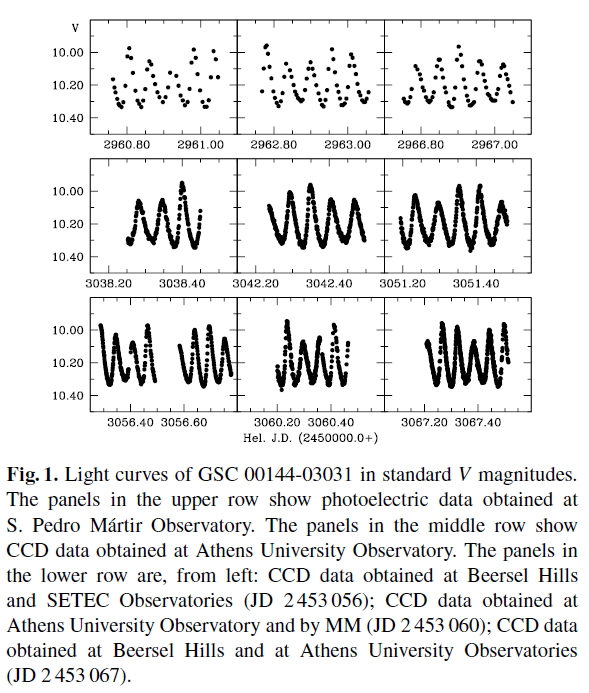
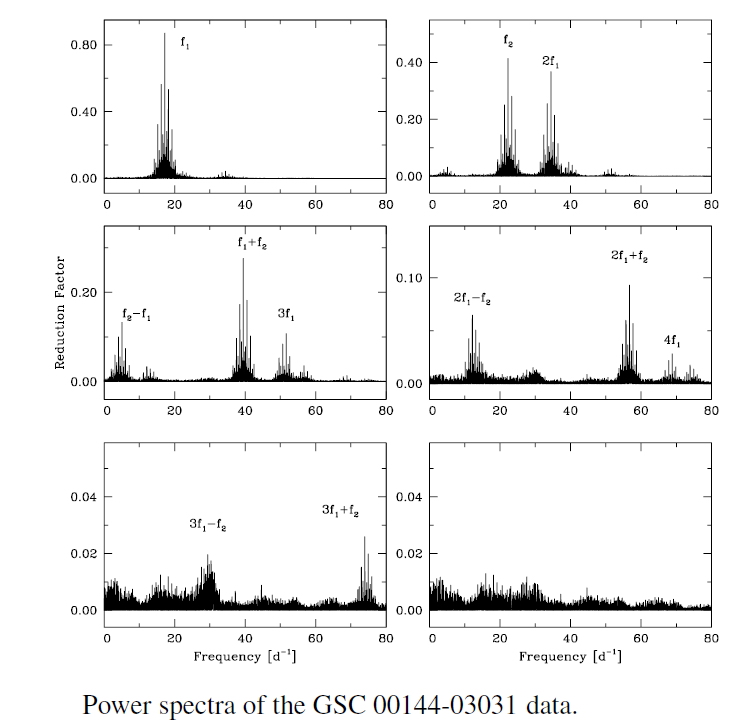
GSC 0144:3031 was intesively investigated from the University of Athens Observatory.
The prototype pulsator RR Lyr, as well as the very similar pulsator XZ Cyg, were observed between 2004-2006 in order to study the Blazhko effect in pulsating stars.
The Blazhko project is still running, coordinated by Dr. K. Kolenberg since 2004. Some preliminary results from the first run of observations are published in
Kolenberg, K., Smith, H. A., Gazeas, K. D., Elmasli, A., Breger, M., Guggenberger, E., van Cauteren, P., Lampens, P., Reegen, P., Niarchos, P. G., Albayrak, B., Selam, S. O., Ozavci, I., Aksu, O., "The Blazhko effect of RR Lyrae in 2003-2004", 2006, A&A, 459, 577,
where it is shown that the Blazhko period is changing over time, changing the shape, amplitude and phase of pulsations of the RR Lyr-type stars.

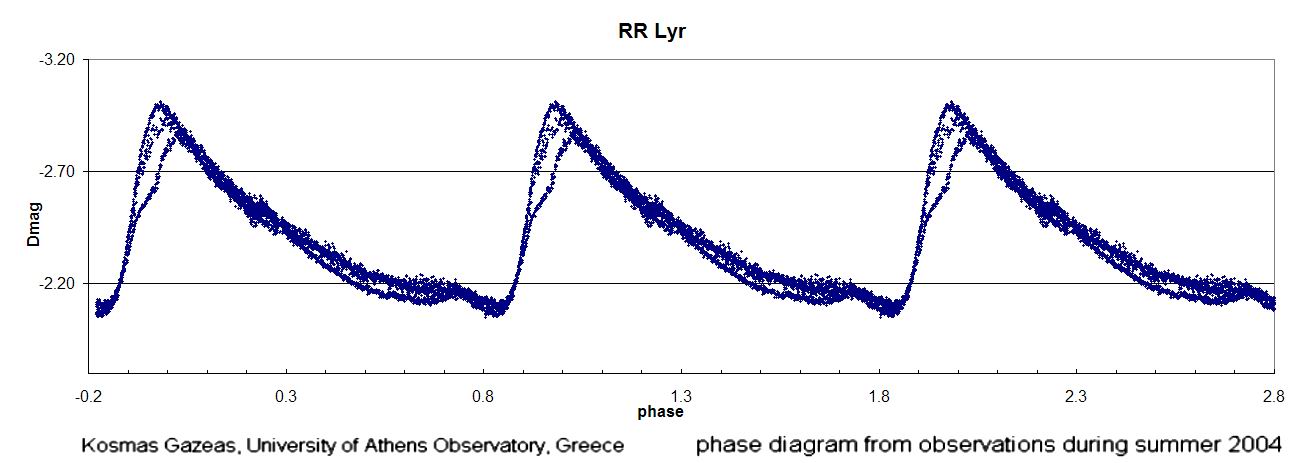
The prototype pulsator RR Lyr shows perfectly the so called Blazhko effect. Each light curve is slightly different than the previous one.
Pulsating stars are not always single in the Universe. Frequently, we observe pulsating stars within an eclipsing binary. Such systems are called
oEA systems
and up to date we know just a few dozens of them.
The University of Athens Observatory has a major contrubution on the study of oEA systems.
A recent study by Liakos & Niarchos (2017, MNRAS, 465, 1181) includes the results of a long-lasting study of oEA systems and presents a list and properties of the
known oEA systems up to date (see images below).
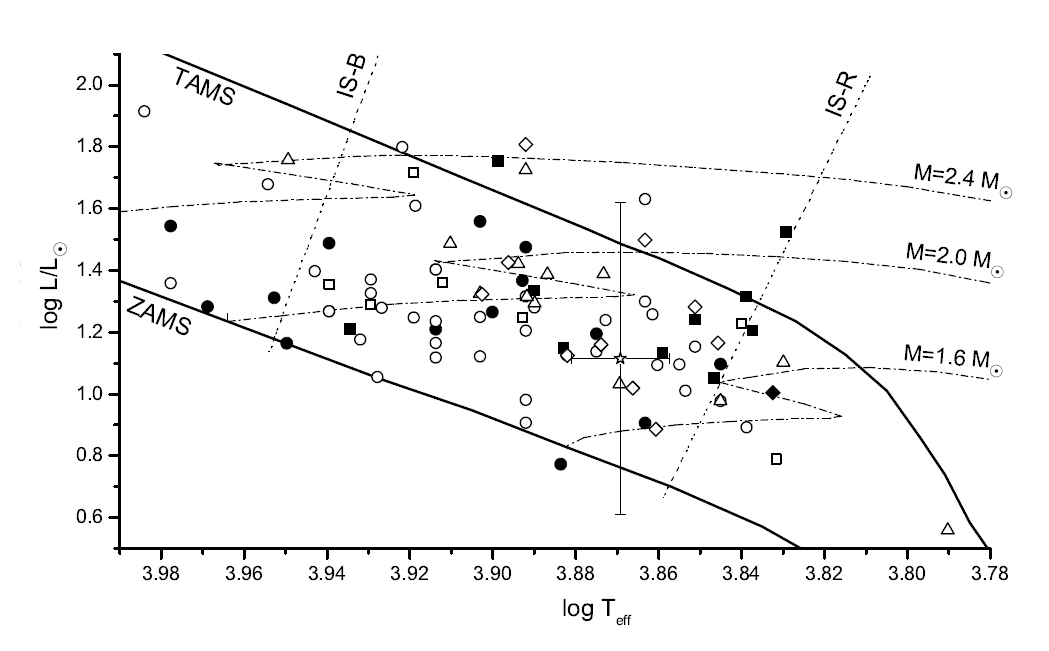
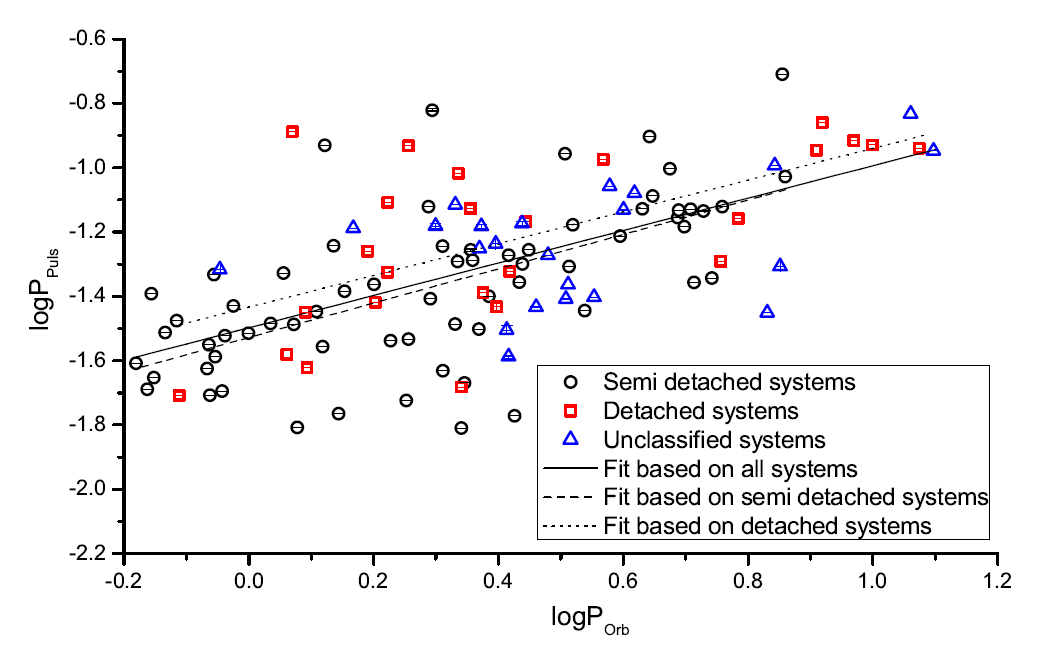
The distribution of binary δ Sct stars within the H-R diagram (left). Dotted lines represent the boundaries of the instability
strip (Blue and Red edges) and the dash-dotted lines the evolutionary tracks for three different initial mass values.
Filled symbols denote the stars with very accurate measured parameters, while the open ones those with less accurate
parameters. Circles, squares, and triangles symbols correspond to the stars that belong to semi-detached, detached, and unclassified
systems with Porb < 13 days, respectively.
The correlation between log Porb-log Ppul of binary δ Sct stars in systems with Porb < 13 days is shown on the right plot. Three different linear
fits (solid, dashed, and dashed-dotted lines) on different data samples (all, semi detached, and detached systems) are shown.
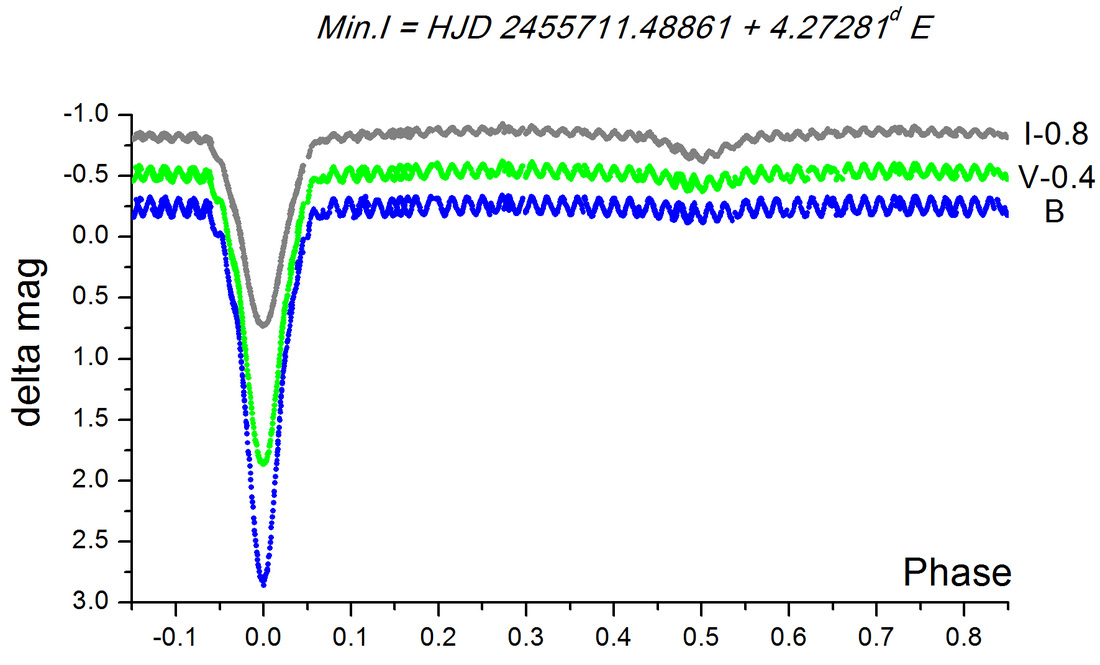
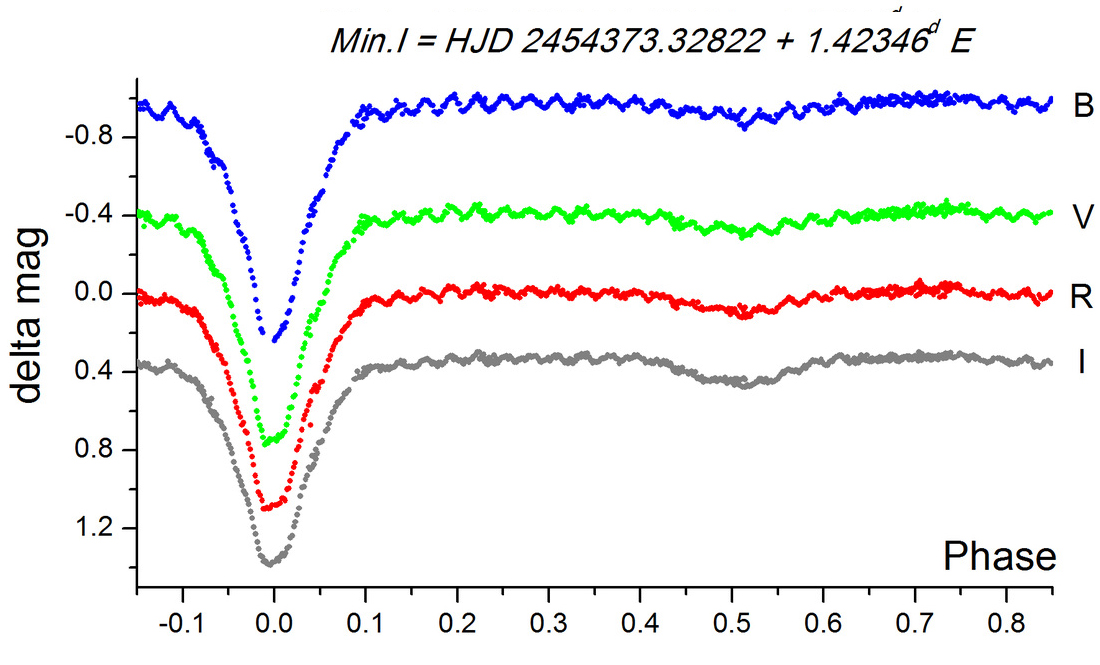
Sample light curve of the eclipsing binary BO Her (left) and TY Cap (right), which shows pulsational behavior, coming from one of its components.
This is a typical behavior for an oEA type of eclipsing binary, where one member of which is a pulsating star. Observations and image courtesy by Dr. A. Liakos.
The University of Athens Observatory participated in several observing campaigns on pulsating stars, which resulted in publications and scientific announcements in refereed journals.










